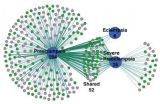(Press-News.org) A physical test for measuring age shows wide differences between the rates of aging among different population groups, according to new research by demographers at the International Institute for Applied Systems Analysis.
A strong handshake can say a lot about a person—it can indicate power, confidence, health, or aggression. Now scientists say that the strength of a person's grasp may also be one of the most useful ways to measure people's true age.
In a new study published today in the journal PLOS ONE, IIASA researchers Serguei Scherbov and Warren Sanderson (also at Stony Brook University) show that hand grip corresponds to other markers of aging such as people's future mortality, disability, cognitive decline, and ability to recover from hospital stays.
For their new research, Sanderson and Scherbov reviewed findings from over 50 published studies that focus on people of all ages around the world. Since the measure is already commonly used, data are readily available. "Hand-grip strength is easily measured and data on hand-grip strength now can be found in many of the most important surveys on aging worldwide," says Sanderson.
The study also demonstrates how such a test could be used as a measure for aging to compare different population groups. The study used data from one such survey, the United States Health and Retirement Survey (HRS), to show how this could be done.
Scherbov says, "We found that based on this survey, a 65-year-old white women who had not completed secondary education has the same handgrip strength as a 69-year-old white women who had completed secondary education. This suggests that according to a handgrip strength characteristic their ages are equivalent and 65 year-old women ages 4 years faster due to lower education attainment."
In a growing body of research funded in part by a new grant from the European Research Council (ERC), Scherbov and Sanderson have begun to define new measures of aging based on people's characteristics, such as their longevity, health, disability status and other important demographic factors.
Previous research by Sanderson and Scherbov has shown that measuring age simply by the number of years people have lived does not measure variations in the aging process correctly. Using new characteristic-based approaches such as the one in this paper, using a physical test like hand-grip, the researchers can identify differences in the aging process between population groups that may not otherwise become apparent.
Scherbov says, "Our goal is to measure how fast different groups in a society age. If some group is getting older faster than another, we can ask why that might be and see whether there are any policies that could help the faster aging group."
INFORMATION:
European Union's Seventh Framework Programme (FP7/2007)/ERC grant agreement to ERC2013-AdG 323947-Re-Ageing.
Reference
Sanderson, W., and S. Scherbov. (2014) Measuring the Speed of Aging Across Population Subgroups. PLOS ONE. http://dx.plos.org/10.1371/journal.pone.0096289
For more information please contact:
Serguei Scherbov
Deputy Program Director
World Population
T +43(0) 2236 807 584
scherbov@iiasa.ac.at
Warren Sanderson
Institute Scholar
World Population
T +43(0) 2236 807 252
T +1 631 828-4117
sanders@iiasa.ac.at
warren.sanderson@stonybrook.edu
Katherine Leitzell
IIASA Press Office
Tel: +43 2236 807 316
Mob: +43 676 83 807 316
leitzell@iiasa.ac.at
About IIASA:
IIASA is an international scientific institute that conducts research into the critical issues of global environmental, economic, technological, and social change that we face in the twenty-first century. Our findings provide valuable options to policy makers to shape the future of our changing world. IIASA is independent and funded by scientific institutions in Africa, the Americas, Asia, Oceania, and Europe. http://www.iiasa.ac.at
A new tool to measure the speed of aging
2014-05-08
ELSE PRESS RELEASES FROM THIS DATE:
UH Rainbow study finds rising incidence of acute pancreatitis in hospitalized children
2014-05-08
The largest investigation to date has found a significant increase in the number of acute pancreatitis (AP) cases in hospitalized children in the United States.
The new study, in the "PLOS ONE" journal found a 51 percent increase in the primary diagnosis of AP from 2000 to 2009. The number increased from 6,350 in 2000 to 9,561 in 2009.
The study looked at hospitalization records of patients 20 years old and younger using a federal children's inpatient database. From 2000 to 2009, they identified 55,012 cases of AP in hospitalized children ages 1 – 20.
According ...
Study finds genetic patterns in preeclampsia
2014-05-08
PROVIDENCE, R.I. [Brown University] — Different manifestations of preeclampsia, such as early vs. late timing or typical vs. high severity, appear to have distinct genetic underpinnings, suggesting that they may need to be studied and treated differently. That and several other insights are described in a newly published comprehensive review of genetic studies of the condition, which produces life-threatening complications such as high-blood pressure in as many as 8 percent of pregnancies in the United States.
"There are probably very different phenotypes of preeclampsia ...
Experts say 'insourcing' innovation may be the best approach to transforming health care
2014-05-08
Philadelphia - A group of health care and policy experts from the Perelman School of Medicine at the University of Pennsylvania is urging health care institutions to look more to their own in-house personnel, including physicians and nurses, as a source of new ideas for improving how care is delivered. The practice – referred to as insourcing – relies on an organization's existing staff to drive needed transformations. The team also suggests a four-stage design process which, when adopted internally, may help organizations implement more efficient health care delivery solutions. ...
New order of marine creatures discovered among sea anemones
2014-05-08
A deep-water creature once thought to be one of the world's largest sea anemones, with tentacles reaching more than 6.5 feet long, actually belongs to a new order of animals. The finding is part of a new DNA-based study led by the American Museum of Natural History that presents the first tree of life for sea anemones, a group that includes more than 1,200 species. The report, which is published today in the journal PLOS ONE, reshapes scientists' understanding of the relationships among these poorly understood animals.
"The discovery of this new order of Cnidaria—a phylum ...
Recent Ebola outbreak highlights need for better global response
2014-05-08
WHAT:In an invited perspective article on the Ebola outbreak under way in West Africa, Heinz Feldmann, M.D., Ph.D., of the National Institutes of Health (NIH) emphasizes the need for scientists to make their data available to colleagues in real-time to improve the public health response to outbreaks. He cites past responses to influenza and SARS (severe acute respiratory syndrome) outbreaks as successful examples of global information sharing. Rapid diagnoses are key to controlling outbreaks of deadly viruses such as Ebola, for which no therapies are available. The immediate ...
Malaria severity not determined solely by parasite levels in blood
2014-05-08
WHAT:
Although malaria kills some 600,000 African children each year, most cases of the mosquito-borne parasitic disease in children are mild. Repeated infection does generate some immunity, and episodes of severe malaria are unusual once a child reaches age 5. However, the relative contributions of such factors as the level of malaria-causing parasites in a person's blood—parasite density—to disease severity and to development of protective immunity are not well understood.
To clarify these issues, researchers from the United States and Tanzania regularly examined 882 ...
Berkeley Lab develops nanoscope to probe chemistry on the molecular scale
2014-05-08
For years, scientists have had an itch they couldn't scratch. Even with the best microscopes and spectrometers, it's been difficult to study and identify molecules at the so-called mesoscale, a region of matter that ranges from 10 to 1000 nanometers in size. Now, with the help of broadband infrared light from the Advanced Light Source (ALS) synchrotron at the U.S. Department of Energy's Lawrence Berkeley National Laboratory (Berkeley Lab), researchers have developed a broadband imaging technique that looks inside this realm with unprecedented sensitivity and range.
By ...
Common drug may help treat effects of muscle disease in boys
2014-05-07
MINNEAPOLIS – A drug typically prescribed for erectile dysfunction or increased pressure in the arteries may help improve blood flow in the muscles of boys with Duchenne muscular dystrophy, according to a study published in the May 7, 2014, online issue of Neurology®, the medical journal of the American Academy of Neurology.
Duchenne muscular dystrophy is a progressive and fatal muscle disease affecting boys and young men that causes loss of muscle function. There is no specific treatment for the disease, which is genetic. Corticosteroids can slow muscle degeneration ...
Multidimensional frailty score helps predict postoperative outcomes in older adults
2014-05-07
A multidimensional frailty score may help predict postoperative outcomes in older adults.
More than half of all operations are performed on patients 65 years and older in the United States. Frail elderly patients who undergo surgery are more likely to have postoperative complications. But tools to estimate operative risk have their limitations because they often focus on a single organ system or solitary event. In geriatric medicine, the comprehensive geriatric assessment (CGA) is widely used to detect disabilities and conditions associated with frailty. The authors sought ...
Kaiser Permanente study finds radiation best treatment for a rare skin cancer
2014-05-07
OAKLAND, Calif. May 7, 2014 — Radiation treatment can help reduce the recurrence of Merkel cell carcinoma, a rare and aggressive skin cancer, while chemotherapy does not appear to have any impact on recurrence or survival, according to a Kaiser Permanente study published online in the current issue of JAMA Dermatology.
The study presents one of the largest single-institution datasets on Merkel cell carcinoma, which occurs in about 1,500 people in the United States annually. Most such cancers occur on the sun-exposed skin of white males and are first diagnosed at age 75, ...



